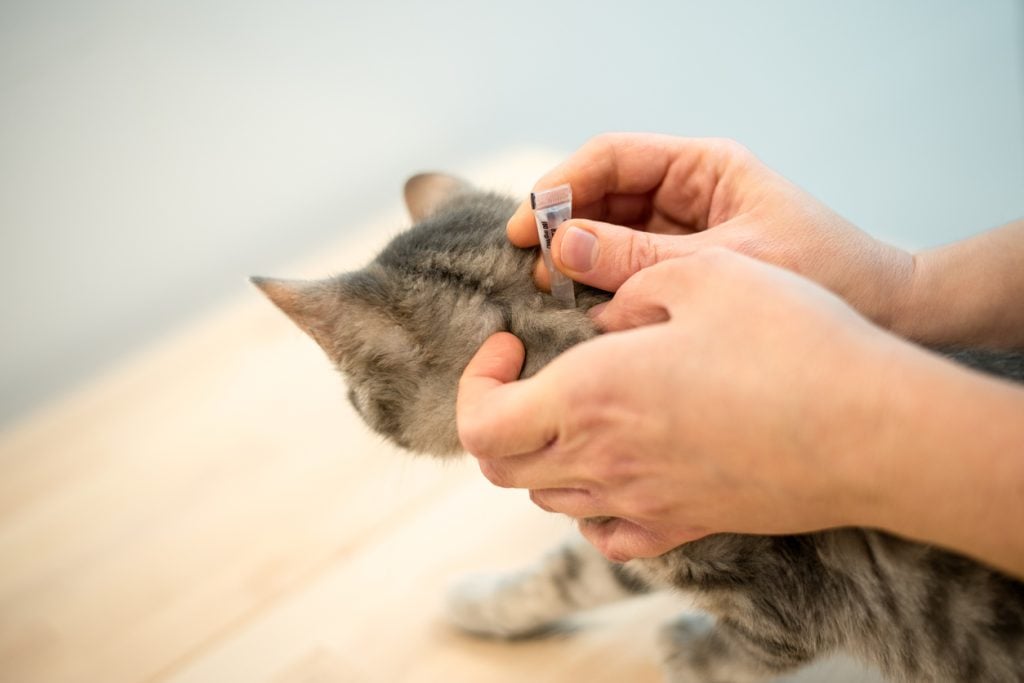Ticks. The very word has me grimacing in revulsion. And I don’t think I’m the only one who feels this way about ticks. Sure, fleas are annoying and can cause problems if your cat or dog has a flea bite allergy, but as far as external parasites go, ticks are in a class by themselves.
There are many species of ticks—and approximately 20 different types here in the UK. While some are somewhat species-specific (for instance, the winter tick prefers large game animals like deer), any of them will bite any mammal, including cats.
You can ask your vet if ticks are endemic to your geographical area and if they are commonly seen on cats or dogs. Dogs are perhaps better known for becoming tick hosts, as they run through the tall grasses where ticks live, waiting for a warm mammal to walk by. But cats are vulnerable, too, and can suffer just like the rest of us with the potential consequences.

Vonschonertagen/iStock
Ticks bite cats (and dogs, and humans, and wildlife) in order to feed and move through the various phases of their life cycle, from the larval stage to nymph to adulthood. An adult female needs to ingest blood to mate and lay the thousands of eggs that will develop into the next generation of ticks.
The problem with ticks isn’t the bite itself, although that’s nasty enough, but the many illnesses they carry and can pass on to your cat. If the tick is carrying an infectious disease, the pathogens will enter your cat’s bloodstream and quickly begin to reproduce.
Tick-Borne Disease in Cats
Most of us are familiar with Lyme disease and the fact that ticks are the vector that passes on this very serious condition. If left untreated, Lyme disease can cause joint damage, cardiac issues, kidney disease, and even neurological symptoms. Fortunately, cats are very resistant to the bacteria that cause Lyme and only rarely show signs of the disease.
The viral tick-borne encephalitis can potentially be passed onto cats in the UK, though this is extremely rare. Another more prevalent risk is the bacteria haemoplasmas (also known as haemobartonellosis). It’s fairly common and is caused by a bacterial parasite that attacks a cat’s red blood cells and can cause life-threatening levels of anaemia. Pale gums, lethargy, loss of appetite and rapid or open-mouthed breathing are the symptoms.
Cats travelling abroad to Europe may be at risk of more diseases, such as ehrlichiosis. Babesiosis, which is a low risk to dogs in some parts of the UK, is not currently thought to affect cats.
Keeping Your Cat Tick-Free
These are just a few of the reasons ticks give me the heebie-jeebies. An internet search will bring up dozens more. So, as we head into prime tick season, keeping ahead of ticks is paramount to your cat’s health and wellbeing. Prevention is key, and much better than cure.
One of the easiest ways to keep your cat safe, healthy, and free of ticks is to keep them indoors. But this is not always feasible or in the best interests of a cat, especially those used to being outdoors.
Prevention
For preventing a tick bite, there are many products to use, from external spot treatments to oral medication prescribed by your vet. Flea and tick powders, sprays, and even collars can all be used to both repel and kill ticks on your cat.
Be careful with any over-the-counter products you purchase. Be sure the product you use is approved for use on cats, and use only in the manner and amount recommended. Talk with your veterinarian about products that work in your area and are safe for use on cats.
Treat the Environment
If ticks are a problem in your area, keeping garden shrubs and grasses neatly trimmed will provide fewer hiding places for ticks.
Treating the garden with products designed to kill and/or repel ticks can be helpful, but these products are often toxic to the environment—and your pets—so research them fully and speak with your veterinarian if you have any concerns.
Remember that cats groom themselves and can ingest products that brush against their fur. Keeping away ticks at the expense of illness isn’t an improvement. If your property is infested, consider hiring a professional exterminator.
Check for Ticks
If your cat is an indoor/outdoor cat, or a barn cat earning his living by keeping your farm free of mice and rats, he’s especially susceptible to acquiring ticks. Even if he’s on a tick preventative or wears a flea and tick collar, check for ticks at least once a day.
To check for ticks, smooth your hands over his fur and run a comb through it, stopping at any unusual bumps. Ticks are commonly seen around the face, ears, and around the mouth. Ticks also like to hide in areas like under the legs (‘armpit’ area), between the toes or under the chin. If your cat wears a collar, be sure to check around and beneath the collar, too.

AleksandarNakic/iStock
How to Remove a Tick from Your Cat
If you find a tick on your cat it’s important to remove it immediately. If a tick has been on your pet for less than 24 hours, the transmission of any tick-borne disorder is very small.
According to PetMD, the best way to remove a tick is fairly simple. Part the fur around it and grab it at the base with a pair of tweezers, being careful not to pinch the tick’s body. Pull it straight out—do not twist—slowly, and then kill the tick by putting it in alcohol. There are also specially designed tick removers on the market, too.
Do not squash the tick with your fingers, and it’s wise to wear gloves, as ticks can transmit diseases to humans. Once it’s dead, dispose of the tick.



